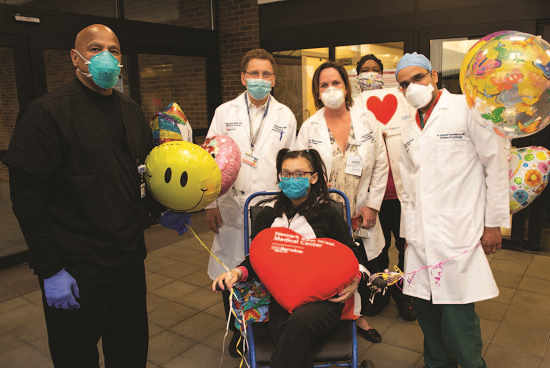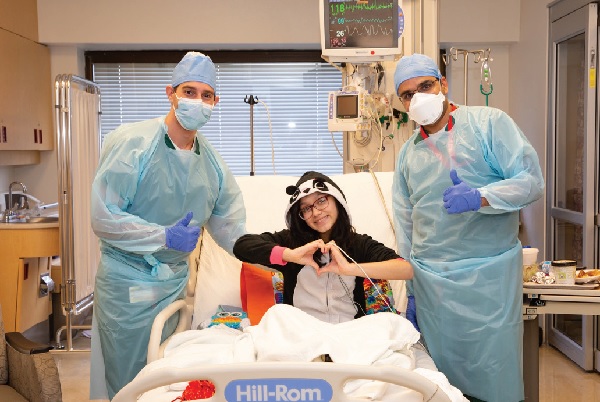“It was the working together of many different teams, all working in synchrony, that saved the life and saved the leg of this 12-year-old girl."

When a huge blood clot blocked a young girl's blood flow, a deep bench of medical experts helped her survive.
It generally doesn’t set off any red flags when an active 12-year-old girl complains that her leg hurts. But in Jissel Rosario’s case, the pain signaled a life-threatening condition.
Last April, when Jissel first complained about the stabbing pain in her left thigh, the COVID-19 epidemic was raging through the northern New Jersey area. Jissel and her mother were afraid to go to the hospital because of the virus, but the girl’s leg was so swollen and painful that her mother brought her to a local urgent care center.
There, the leg pain was misdiagnosed as cellulitis—a bacterial infection—and Jissel was prescribed an antibiotic. But the pain continued to get worse.
A few days later, Jissel’s leg had swelled to three times its normal size and her foot had turned purple. Her mother brought her to a nearby emergency department, where doctors detected a large blood clot that was compromising the circulation to her leg.
At that point, Jissel was sent to Newark Beth Israel Medical Center (NBI) and Children’s Hospital of New Jersey.
Emergency Action

“When she came to us, the main vein in her left leg was completely clotted off,” says interventional cardiologist Marc Cohen, MD, Chairman of the Department of Medicine at NBI. “She was almost at risk of losing the leg.”
Because the clot was so extensive, vascular surgeon Cindy Sturt, MD, took Jissel for a procedure called catheter-based thrombectomy, in which an incision into the blood vessel is made and sophisticated equipment sucks the clot out.
“Unfortunately, there’s always a risk of dislodging a blood clot,” explains Dr. Cohen. “In Jissel’s case, a big part of the clot got away and went to her lungs, blocking an artery.”

Jissel’s heart stopped, and the team sprang into action.
“She was resuscitated for almost an hour,” recalls Derrick McQueen, MD, Director of the Pediatric Intensive Care Unit at Children’s Hospital. “The unsung heroes of this story are the catheterization lab staff and the anesthesiologists. They really did outstanding CPR.”
Once Jissel’s heart was restarted, cardiologist Gautam Visveswaran, MD, put her on an ECMO (extracorporeal membrane oxygenation) machine, which replaces the body’s heart and lungs to circulate their blood and keep the patient alive. Jissel was also placed on a mechanical ventilator to take over her breathing.
Meanwhile, doctors treated the blood clots that were now in both her leg and her lungs. “Dr. Visveswaran and I took Jissel to the catheterization lab and passed catheters that dripped TPA [tissue plasminogen activator] into her lungs to dissolve the major blood clot that had snuck in there,” explains Dr. Cohen. “And Dr. Sturt went back to remove as much of the clot remaining in the leg as possible and was able to improve the circulation in the leg.”
Awake Again
There were grave concerns about the potential effect of the ordeal on Jissel’s brain. But after she was taken off the machines, she slowly woke up. Soon, she was talking and laughing in her hospital bed.
“She still needed management for the injury that had occurred,” explains Dr. McQueen.
Wound care specialists, under the direction of Harold Brem, MD, Director of Wound Healing and Regenerative Medicine, were on the case. Because the blood flow to Jissel’s leg and foot had been compromised, she started regular hyperbaric oxygen therapy to help the leg heal.
The pediatric rheumatology and hematology departments also got involved.
“Because of the clotting issue, they decided to do plasmapheresis, in which blood is withdrawn and the plasma separated out, treated, and returned to the patient,” explains Dr. McQueen.
Jissel was in the hospital for three weeks. By the time she left, she had “an incredible recovery of 95 percent of the function of her left foot,” says Dr. Cohen. Jissel will be on anti-clotting medication for the foreseeable future and will continue to be closely monitored.
What was the cause of the blood clot in the leg, an extremely rare occurrence in a child?
NBI doctors believe it was a result of COVID-19, which appears to trigger the formation of blood clots.
Though Jissel tested negative for active infection while she was in the hospital, a test showed that she carried antibodies to the virus and must have been previously exposed.
Says Dr. Cohen, “It was the working together of many different teams, all working in synchrony, that saved the life and saved the leg of this 12-year-old girl.”

Jissel Rosario was in Newark Beth Israel Medical Center for three weeks.
Doctors suspect her blood clot was COVID-19-related.
All Hands on Deck
Young Jissel Rosario was able to survive and thrive due to the extensive range of medical experts at Newark Beth Israel Medical Center and Children’s Hospital of New Jersey.
- Anesthesiology
- Cardiology, Adult, and Pediatric
- Catheterization
- Pediatric Intensive Care
- Pediatric Rheumatology and Hematology
- Pulmonary Critical Care
- Physical Therapy
- Respiratory Therapy
- Vascular Surgery
- Wound Care Program
Your heart doesn’t beat just for you. Get it checked. To find cardiac specialists at Newark Beth Israel Medical Center and Children’s Hospital of New Jersey, request an appointment or call (888) 724-7123.